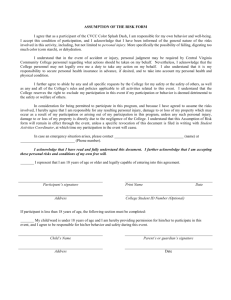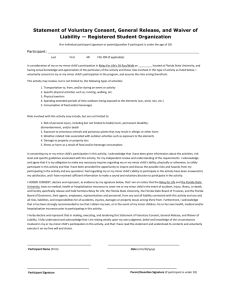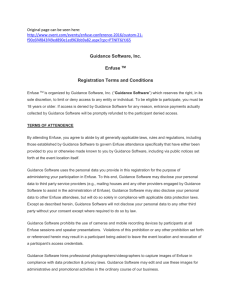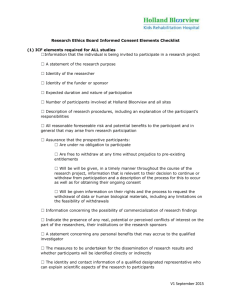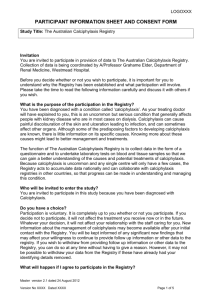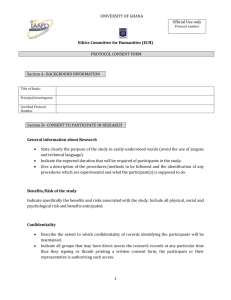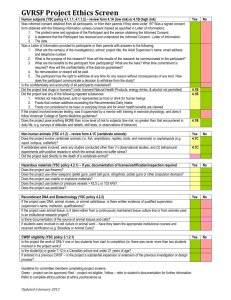Tissue Banking Consent Form - Australian Calciphylaxis Registry
advertisement
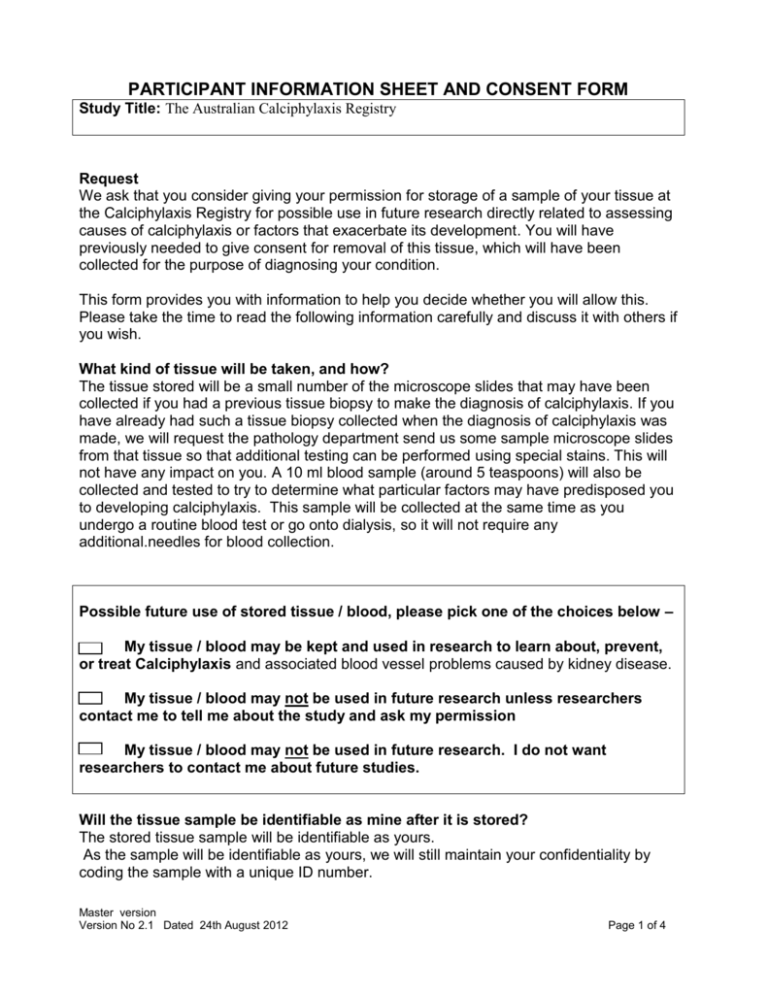
PARTICIPANT INFORMATION SHEET AND CONSENT FORM Study Title: The Australian Calciphylaxis Registry Request We ask that you consider giving your permission for storage of a sample of your tissue at the Calciphylaxis Registry for possible use in future research directly related to assessing causes of calciphylaxis or factors that exacerbate its development. You will have previously needed to give consent for removal of this tissue, which will have been collected for the purpose of diagnosing your condition. This form provides you with information to help you decide whether you will allow this. Please take the time to read the following information carefully and discuss it with others if you wish. What kind of tissue will be taken, and how? The tissue stored will be a small number of the microscope slides that may have been collected if you had a previous tissue biopsy to make the diagnosis of calciphylaxis. If you have already had such a tissue biopsy collected when the diagnosis of calciphylaxis was made, we will request the pathology department send us some sample microscope slides from that tissue so that additional testing can be performed using special stains. This will not have any impact on you. A 10 ml blood sample (around 5 teaspoons) will also be collected and tested to try to determine what particular factors may have predisposed you to developing calciphylaxis. This sample will be collected at the same time as you undergo a routine blood test or go onto dialysis, so it will not require any additional.needles for blood collection. Possible future use of stored tissue / blood, please pick one of the choices below – My tissue / blood may be kept and used in research to learn about, prevent, or treat Calciphylaxis and associated blood vessel problems caused by kidney disease. My tissue / blood may not be used in future research unless researchers contact me to tell me about the study and ask my permission My tissue / blood may not be used in future research. I do not want researchers to contact me about future studies. Will the tissue sample be identifiable as mine after it is stored? The stored tissue sample will be identifiable as yours. As the sample will be identifiable as yours, we will still maintain your confidentiality by coding the sample with a unique ID number. Master version Version No 2.1 Dated 24th August 2012 Page 1 of 4 PARTICIPANT INFORMATION SHEET AND CONSENT FORM Study Title: The Australian Calciphylaxis Registry What will happen to my tissue sample? Your sample will be stored for three years at Westmead Hospital, ICPMR. We wish to store (or ‘bank’) the sample for potential research on calciphylaxis or associated blood vessel problems caused by kidney disease. Not all potentially beneficial future research can be known at any one time, as the need for future research is determined by ongoing developments in the field. How will I know if my samples are being used in the future? If you agree to your tissue sample/s being stored for future research, they may only be used for research projects in the future with the approval of a Human Research Ethics Committee. The Human Research Ethics Committee will determine whether, or not, your consent should be obtained at that time for a particular research project. Notifying you and obtaining your consent for specific research will be possible as the stored sample is linked to your identifying information. It will be possible to provide you with feedback about the findings of potential future research. Who will have access to my tissue sample once it has been stored? The custodians charged with ensuring appropriate standards are met in storing and managing the tissue bank will have access to your sample. Researchers involved in research approved by a Human Research Ethics Committee may also have access to your sample. Will drug or biotechnology companies be able to use my sample for profit in the future?’ No, your blood or tissue sample will not be used for profit by any drug or biotechnology company. However, there is the possibility that research based upon blood or tissue samples stored in the Australian Calciphylaxis Registry may result in commercially viable technology or treatments. You will not however be able to claim financial benefit from any discoveries arising from this research. How long will my tissue sample be stored?’ Your tissue sample will be stored for 3 years. The sample will be destroyed at the end of this period. Will I be able to get my sample back if I change my mind once it has been stored in the ‘tissue bank’?’ Your sample microscope slide or slides could be returned to your hospital pathology department, providing the slides were still available in storage and have not been used. Master version Version No 2.1 Dated 24th August 2012 Page 2 of 4 PARTICIPANT INFORMATION SHEET AND CONSENT FORM Study Title: The Australian Calciphylaxis Registry The blood sample would be unsuitable to be returned but if still available could be discarded at your request.. . Complaints This study has been approved by Western Sydney Local Health District Human Research Ethics Committee. If you have any concerns about the conduct of the study, or your rights as a study participant, you may contact: XXXXXX, XXXXX Hospital Patient Representative, (Contact details: Telephone XXXXXX Email address: XXXXXXXXX). Contact details When you have read this information, the researcher [XXXXX] will discuss it with you and any queries you may have. If you would like to know more at any stage, please do not hesitate to contact him/her on number – XXXXXXX. If you have any problems while on the study, please contact Dr Working hours Telephone No – After hours Telephone No ( ) or via the hospital switchboard No xxxx Pager No xxxxx for clinical trials (or mobile for other studies) Thank you for taking the time to consider this study. Master version Version No 2.1 Dated 24th August 2012 Page 3 of 4 PARTICIPANT INFORMATION SHEET AND CONSENT FORM Study Title: The Australian Calciphylaxis Registry CONSENT TO PARTICIPATE IN RESEARCH Name of Chief Investigator : XXXXXXXX 1. I understand that the researcher will conduct this study in a manner conforming to ethical and scientific principles set out by the National Health and Medical Research Council of Australia and the Good Clinical Research Practice Guidelines of the Therapeutic Goods Administration. 2. I acknowledge that I have read, or have had read to me the Participant Information Sheet relating to this study. I acknowledge that I understand the Participant Information Sheet. I acknowledge that the general purposes, methods, demands and possible risks and inconveniences which may occur to me during the study have been explained to me by ____________________________ (“the researcher”) and I, being over the age of 16 acknowledge that I understand the general purposes, methods, demands and possible risks and inconveniences which may occur during the study. 3. I acknowledge that I have been given time to consider the information and to seek other advice. 4. I acknowledge that refusal to take part in this study will not affect the usual treatment of my condition. 5. I acknowledge that I am volunteering to take part in this study and I may withdraw at any time. 6. I acknowledge that this research has been approved by the Western Sydney Local Health District Human Research Ethics Committee. 7. I acknowledge that I have received a copy of this form and the Participant Information Sheet, which I have signed. 8. I acknowledge that any regulatory authorities may have access to my medical records relevant to this study to monitor the research in which I am agreeing to participate. However, I understand my identity will not be disclosed to anyone else or in publications or presentations. Before signing, please read ‘IMPORTANT NOTE’ following. IMPORTANT NOTE: This consent should only be signed as follows: 1. Where a participant is over the age of 16 years, then by the participant personally. Name of participant ______________________________ Date of Birth ____________________ Address of participant ____________________________________________________________ Signature of participant _____________________________Date: __________________________ Signature of researcher ____________________________ Date: __________________________ Signature of witness ________________________________Date: ________________________ Master version Version No 2.1 Dated 24th August 2012 Page 4 of 4
